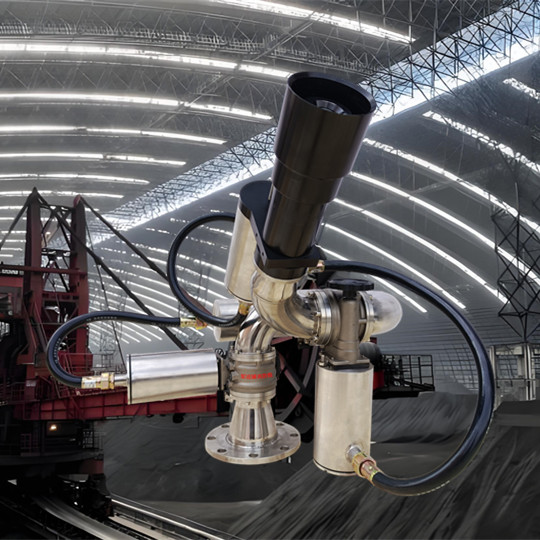Intelligent fire water cannons have become essential fire-fighting equipment in large - space places such as warehouses and factories. Their common models include 5L/S, 10L/S, 20L/S, 30L/S and larger flow specifications. However, the larger the flow rate of the fire water cannon, the higher the required rated pressure, and the larger the parameters of supporting pipelines, fire pools, fire pumps, etc., which in turn leads to a significant increase in engineering costs. If a smart fire water cannon with a small flow rate is chosen, there is a concern that it may not meet the specification requirements. So, in which scenarios can more economical intelligent fire water cannons be used?

1. Which model of intelligent fire water cannon is more economical?
For various models of intelligent fire water cannon systems, different models have different flow rates and prices. Usually, 5L/S and 10L/S belong to one range and are classified as automatic jet fire extinguishing systems; 20L/S and 30L/S belong to another range and are automatic fire cannon fire extinguishing systems. Although their control systems are the same and the cost is similar for manufacturers, the fire water cannon system needs to work in coordination with supporting facilities such as pools, water pumps, pipelines and valves. The larger the flow rate of the fire water cannon system, the greater the capacity requirement of its supporting equipment, and the corresponding engineering cost will increase significantly. Generally speaking, among the common models at present, the 5L and 10L flow water cannons are more economical in terms of the overall project cost.
2. Which clauses of the specification should be met for model selection?
The core basis for specification selection is the part about fixed fire cannons and automatic tracking and positioning jet fire extinguishing systems in the "Technical Standard for Automatic Tracking and Positioning Jet Fire Extinguishing Systems" and "General Specification for Fire Protection Facilities".
Relevant regulations point out that the selection of automatic tracking and positioning jet fire extinguishing systems should comply with the following provisions:
- For light hazard level places, jet - type automatic jet fire extinguishing systems or sprinkler - type automatic jet fire extinguishing systems should be preferred;
- For medium hazard level places, jet - type automatic jet fire extinguishing systems, sprinkler - type automatic jet fire extinguishing systems or automatic fire cannon fire extinguishing systems should be preferred;
- For Class C warehouses, automatic fire cannon fire extinguishing systems should be preferred;
- One system type should be used in the same protection area. When it is really necessary, a combination of two types of systems can be used.
Then, how to divide light hazard level places, medium hazard level places and Class C warehouses?
According to the "Code for Design of Automatic Sprinkler Systems", light hazard level places generally refer to places with low fire risk, few combustibles, slow spread speed after fire, and easy initial fire fighting, such as residential buildings, kindergartens, elderly care facilities, etc. In these places, personnel activities are relatively regular, the types and quantities of combustibles are limited, and the development trend after a fire is relatively mild.
Medium hazard level places are subdivided into medium hazard level I and II. Medium hazard level I places include high - rise civil buildings (such as hotels, office buildings, complex buildings, etc.), public buildings (such as hospitals, libraries, exhibition halls, etc.), cultural heritage buildings (such as ancient wooden structures, national cultural relics protection units, etc.) and preparation and production workshops of factories producing food, household appliances, glass products, etc. in industrial buildings. These places have a relatively high density of people, a relatively large number of types and quantities of combustibles, and after a fire, there is a certain spread speed and difficulty in fighting. Medium hazard level II places include cinemas and theaters in civil buildings, shopping malls with a total construction area of more than 5000 square meters, etc., as well as preparation and production workshops of factories engaged in textile, fabric and products of cotton, wool, hemp, silk and chemical fibers, wood, wood products and plywood, grain processing, tobacco and products, drinking alcohol (excluding beer), leather and products, papermaking and paper products, pharmaceuticals, etc. in industrial buildings. Such places have a greater fire load, and the fire risk and difficulty in fighting are further increased.
Class C warehouses refer to warehouses storing Class C goods, which include liquids with a flash point of not less than 60℃ and combustible solids. Common examples are warehouses storing liquids with high flash points such as asphalt and lubricating oil, as well as warehouses storing various combustible goods (such as wood, cartons, textiles, etc.). Due to the combustibility of the stored goods in these warehouses, once a fire breaks out, the fire tends to be large and spreads rapidly, so the fire fighting capacity of fire protection facilities is required to be high.
In the actual selection of intelligent fire water cannon models, if the place is judged to be of light hazard level, priority should be given to the 5L/S flow jet - type automatic jet fire extinguishing system or sprinkler - type automatic jet fire extinguishing system, which can not only meet the specification requirements but also achieve economic investment. For medium hazard level places, when the space is small and the fire load is relatively small, the 10L/S flow jet - type or sprinkler - type automatic jet fire extinguishing system may be a more economical choice; for medium hazard level places with large space and large fire load, the 20L/S and above flow automatic fire cannon fire extinguishing systems may be more in line with the requirements. Although the engineering cost is high, it can ensure fire safety. For Class C warehouses, due to their high fire risk, automatic fire cannon fire extinguishing systems with a flow rate of 20L/S and above are usually needed to ensure that the fire can be effectively controlled and extinguished when a fire occurs. At the same time, in the same protection area, one system type should be chosen as far as possible to reduce system complexity and cost; only in special cases, such as complex building structures and large differences in fire characteristics in different areas, the combination of two types of systems should be considered. However, at this time, it is necessary to comprehensively evaluate the cost and fire fighting effect to ensure the rationality of the overall scheme.






